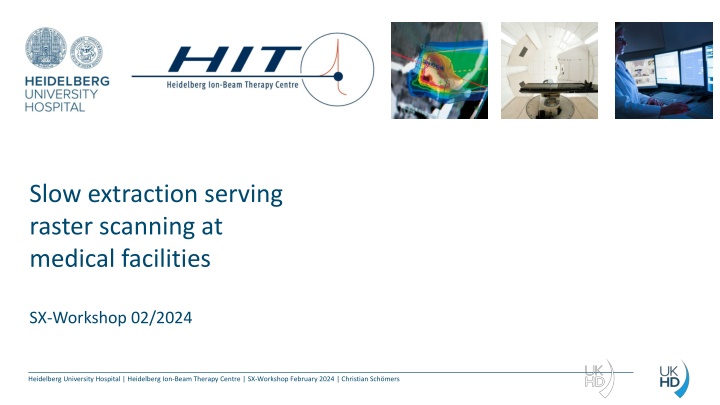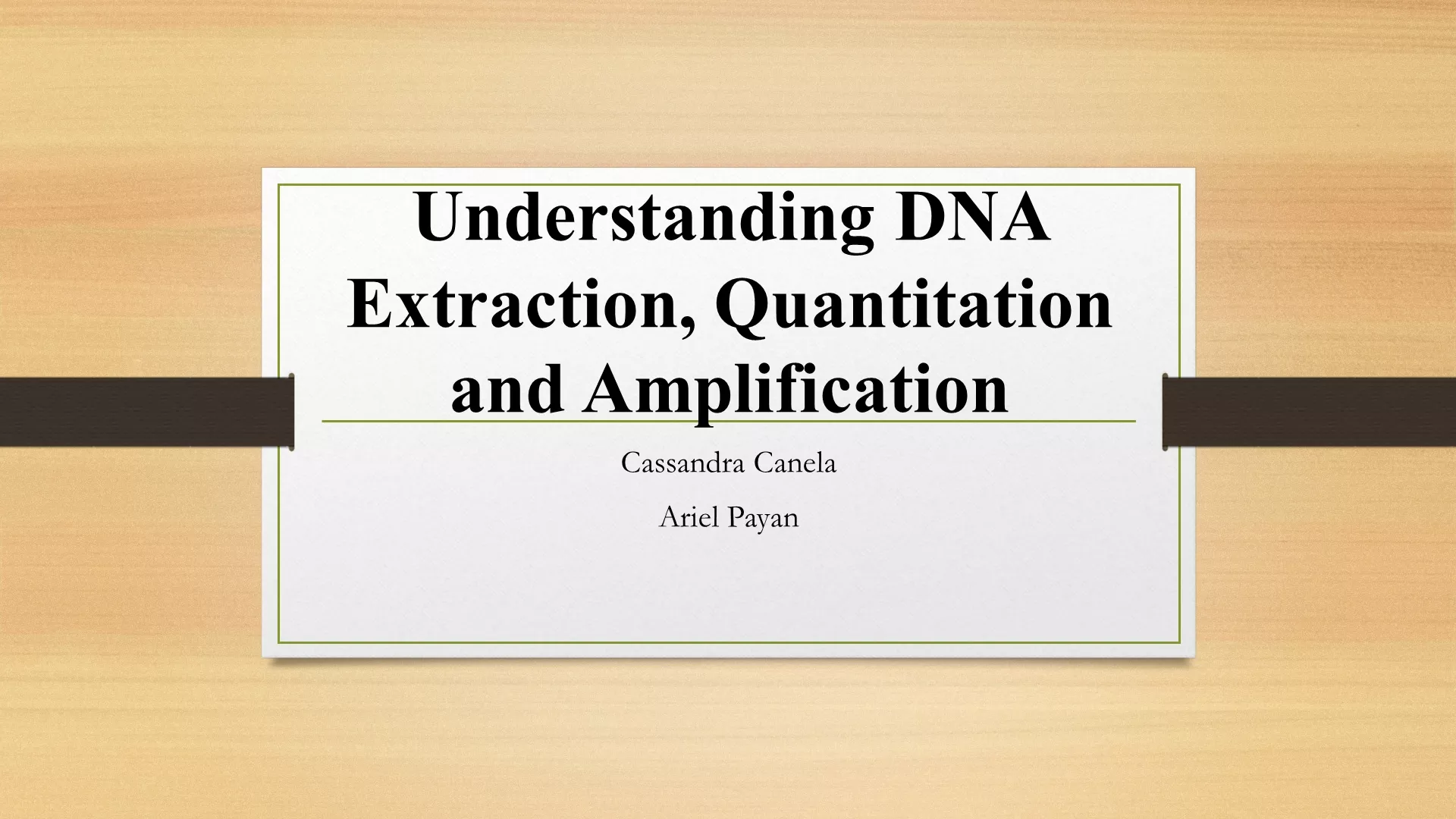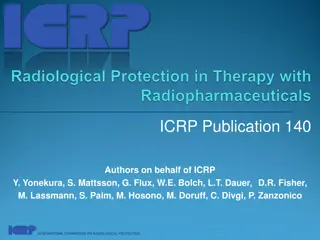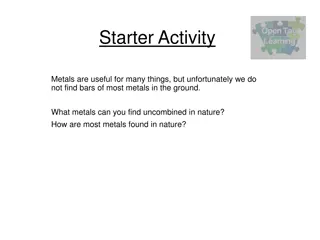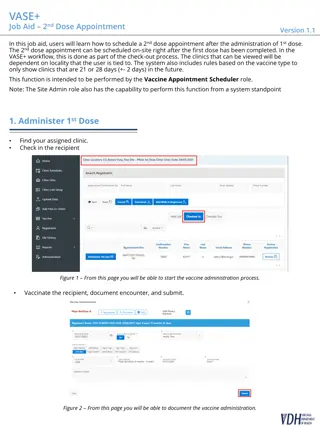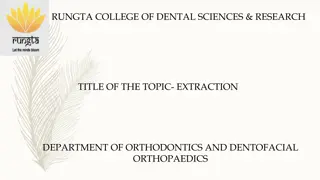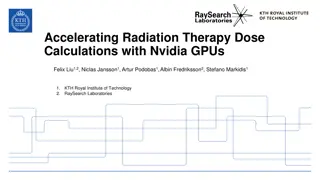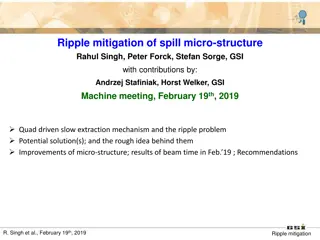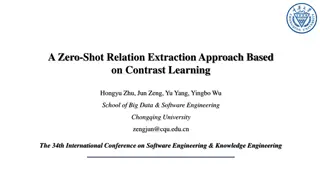Advances in Particle Therapy: Slow Extraction and Dose Delivery at Medical Facilities
Medical facilities, like Heidelberg University Hospital, utilize advanced techniques such as slow extraction and raster scanning for precise dose delivery in particle therapy. The demands on these facilities include safe and precise beam parameters, uninterrupted therapy sessions, and fast irradiation times. Future topics in particle therapy focus on enhancing delivery systems and optimizing treatment outcomes. Intensity control systems play a crucial role in ensuring accurate therapy dosages.
Download Presentation

Please find below an Image/Link to download the presentation.
The content on the website is provided AS IS for your information and personal use only. It may not be sold, licensed, or shared on other websites without obtaining consent from the author.If you encounter any issues during the download, it is possible that the publisher has removed the file from their server.
You are allowed to download the files provided on this website for personal or commercial use, subject to the condition that they are used lawfully. All files are the property of their respective owners.
The content on the website is provided AS IS for your information and personal use only. It may not be sold, licensed, or shared on other websites without obtaining consent from the author.
E N D
Presentation Transcript
Slow extraction serving raster scanning at medical facilities SX-Workshop 02/2024 Heidelberg University Hospital | Heidelberg Ion-Beam Therapy Centre | SX-Workshop February 2024 | Christian Sch mers
Outline What are the current demands medical facilities make on slow extraction? What are the future topics much discussed in particle therapy and what do they impose on slow extraction? Heidelberg University Hospital | Heidelberg Ion-Beam Therapy Centre | SX-Workshop February 2024 | Christian Sch mers
What are medical facilities? In the accelerator context Particle Therapy Centers doing patient treatment with protons or heavier ions 105 Protons 14 Carbon (+ p) ptcog.ch/ (Jan. 2024) Facilities in operation only. 18 31 2 2 46 3 Heidelberg University Hospital | Heidelberg Ion-Beam Therapy Centre | SX-Workshop February 2024 | Christian Sch mers
What makes a medical facility special? Beam target is a patient! Mission: provide particle beams in therapy quality 335 days / year Avoid any interruptions to guarantee therapy success The dose delivery must be safe and precise Fast: reduction of irradiation time only without affecting safety and precision Large variety of beam parameters (ion types, energy steps, spot sizes, intensity range, gantry angles) Heidelberg University Hospital | Heidelberg Ion-Beam Therapy Centre | SX-Workshop February 2024 | Christian Sch mers
Raster-scanning dose delivery Tumor is irradiated slice-by-slice and spot-by-spot Accelerator delivers pencil beams of different ion energies (penetration depth) Guided by scanning magnets Monitored in position, width and intensity Scanning process needs milliseconds per spot Beam spill of several seconds is needed Position and intensity is measured, the scanning velocity is adapted Dose- delivery system 5 Heidelberg University Hospital | Heidelberg Ion-Beam Therapy Centre | SX-Workshop February 2024 | Christian Sch mers
Intensity control system Use intensity signal Add feedback loop Position and intensity is measured, the scanning velocity and the intensity are adapted Therapy- Control- System Intensity feedback loop RF-KO exciter 6 Heidelberg University Hospital | Heidelberg Ion-Beam Therapy Centre | SX-Workshop February 2024 | Christian Sch mers
Why a raster-point-individual intensity makes sense if you have an intensity control ions Dose in each voxel dose per raster-point Example of dose distribution of one slice Fixed intensity: irradiation time per raster point can vary by a factor of 2000! reference spill C. Schoemers et al, Nuclear Instruments and Methods in Physics Research Section A: Accelerators, Spectrometers, Detectors and Associated Equipment, Volume 795, 21 September 2015, Pages 92-99, ISSN 0168-9002, http://dx.doi.org/10.1016/j.nima.2015.05.054 Heidelberg University Hospital | Heidelberg Ion-Beam Therapy Centre | SX-Workshop February 2024 | Christian Sch mers
Main interruptions due to safety-interlocks related to intensity IC interlock for too fast extraction / spikes: If dose monitors detect intensity too large, close to current measurement range. MWPC interlock for too fast irradiation Time-out for too slow/delayed extraction (happens only if not intensity controlled) Heidelberg University Hospital | Heidelberg Ion-Beam Therapy Centre | SX-Workshop February 2024 | Christian Sch mers
Main interruptions due to safety-interlocks related to intensity IC interlock for too fast extraction / spikes MWPC interlock for too fast irradiation: If some raster-points (@ HIT: >3) are irradiated too fast without proper position measurement. Time-out for too slow/delayed extraction (happens only if not intensity controlled) Heidelberg University Hospital | Heidelberg Ion-Beam Therapy Centre | SX-Workshop February 2024 | Christian Sch mers
Spillpause mechanism to spare healthy tissue Spill pause is a fast beam-off mechanism Pause and resume the beam extraction several times on flattop RF-KO allows spill pause Used for: Scanning without dose deposition Respiratory gating Gating movement Scan path Target Irradiation window Tumour Time Courtesy of S. Nill & U. Oelfke, DKFZ, C. Bert et al Heidelberg University Hospital | Heidelberg Ion-Beam Therapy Centre | SX-Workshop February 2024 | Christian Sch mers
Conclusion: Ideal spill for therapy today Intensities in the order of 107 108/s (Carbon) and 109 1010/s (Protons) Intensity controlled (different dose requirements) Low spill ripple in the regime of 1ms due to raster-scanning Low spill ripple up to the frequency your dose delivery system sees ( spikes ) Bunched beam extraction is ok Spill pause available to shortly interrupt the scanning e.g. also for respiratory gating Heidelberg University Hospital | Heidelberg Ion-Beam Therapy Centre | SX-Workshop February 2024 | Christian Sch mers
Future Projects in IMPT and their impact on SX Heidelberg University Hospital | Heidelberg Ion-Beam Therapy Centre | SX-Workshop February 2024 | Christian Sch mers
FLASH-effect Ultra High Dose Rate (UHDR) Irradiations What is uHDR: dose rates > 40Gy/s (while standard dose rates (SDR) are << 1Gy/s) Under investigation: are there biologic benefits when applying uHDR? FLASH effect : normal tissue sparing without sacrificing tumour control? T. Tessonnier, S. Mein, D.W.M. Walsh, N. Schuhmacher, H. Liew, U. Weber, R. Cee, M. Galonska, C. Sch mers, S. Scheloske, S. Brons, J. Debus, T. Haberer, A. Abdollahi, A. Mairani, and I. Dokic. FLASH dose-rate helium ion beams in vitro. International Journal of Radiation Oncology, Biology, Physics, 2021. Heidelberg University Hospital | Heidelberg Ion-Beam Therapy Centre | SX-Workshop February 2024 | Christian Sch mers
FLASH-effect Ultra High Dose Rate (UHDR) Irradiations HIT uHDR-spills Intensity controlled Optics for faster (but still slow) extraction (increased sextupole strength, quadrupoles closer to 3rdorder resonance. Dose rates up to 200 Gy/s. Example helium: 3.5e10 particles in 90ms 3.9e10 part./s. > 50 times higher than therapy Still applying high quality raster-scanning C. Sch mers, S. Brons, R. Cee, A. Peters, S. Scheloske, T. Haberer, BEAM PROPERTIES BEYOND THE THERAPEUTIC RANGE AT HIT , in Proc. IPAC 23, Venice, Italy, May 2023, paper THPM064, http://doi/jacow-ipac2023-thpm064/index.html Heidelberg University Hospital | Heidelberg Ion-Beam Therapy Centre | SX-Workshop February 2024 | Christian Sch mers
FLASH-effect Ultra High Dose Rate (UHDR) Irradiations Future challenges for SX Up to now: total dose was independent of the dose rate; If the Flash-effect is true: dose or biological effectiveness depends on dose rate! Dose rate will be a significant parameter for the treatment planning system We have to provide stable, predictable spills of a certain uHDR intensity. Walter Tinganelli, Olga Sokol, Martina Quartieri, Anggraeini Puspitasari, Ivana Dokic, Amir Abdollahi, Marco Durante, Thomas Haberer, J rgen Debus, Daria Boscolo, Bernd Voss, Stephan Brons, Christoph Schuy, Felix Horst, and Ulrich Weber. Ultra-high dose rate (FLASH) carbon ion irradiation: dosimetry and first cell experiments. International Journal of Radiation Oncology, Biology, Physics, 2021. Heidelberg University Hospital | Heidelberg Ion-Beam Therapy Centre | SX-Workshop February 2024 | Christian Sch mers
iRAD Ion Beam Radiography Detector Object / Patient Idea of ion beam radiography: use particle beams also for imaging Good for treatment planning same radiation for image and treatment Possibility of in situ monitoring T. Gehrke et al., Theoretical and experimental comparison of proton and helium-beam radiography using silicon pixel detectors , Phys. Med. Biol., vol. 63, no. 3, p. 035037, Feb. 2018. https://doi:10.1088/1361-6560/aaa60f A. Burker et al., Imaging with Ion Beams at MedAustron , Nuclear Inst. and Methods in Physics Research, A 958 (2020) 162246, https://doi.org/10.1016/j.nima.2019.05.087 Heidelberg University Hospital | Heidelberg Ion-Beam Therapy Centre | SX-Workshop February 2024 | Christian Sch mers
A mixed He-C beam iRAD Ion Beam Radiography Carbon Helium mixed beam Fully ionized Helium and Carbon (nearly) same mass:charge ratio Can be accelerated to same velocity - range of4He2+ 3 x range of12C6+ 700 70 Carbon 250 MeV/u Helium 250 MeV/u Treatment and online monitoring at the same time Accelerate 2 ions with same a/q to same energy Carbon ions stop in the patient Helium ions stop in detector Simultaneous extraction! 600 60 Carbon: dE/dz [MeV/(g cm )] Helium: dE/dz [MeV/(g cm )] 500 50 Exits patient, stops in detector Stops in target 400 40 300 30 200 20 100 10 0 0 0 10 20 Range [g/cm ] 30 40 50 GSI Helmholtzzentrum f r Schwerionenforschung GmbH L. Volz, L. Kelleter, S. Brons, L. Burigo, C. Graeff, N. I. Niebuhr, R. Radogna, S. Scheloske, C. Sch mers, S. Jolly, and J. Seco. Experimental exploration of a mixed helium/carbon beam for online treatment monitoring in carbon ion beam therapy. Physics in Medicine & Biology, 65(5):055002, feb 2020. C. Knobloch, M. Metzner, F. Kehrein, C. Sch mers, S. Scheloske, S. Brons, R. Hermann, A. Peters, O. J kel, M. Martisikova and T. Gehrke. Establishment and evaluation of a water-equivalent thickness calibration for helium-beam radiography with high-energy beams and thin silicon pixel detectors. Medical Physics, to be published 2022 Heidelberg University Hospital | Heidelberg Ion-Beam Therapy Centre | SX-Workshop February 2024 | Christian Sch mers
iRAD Ion Beam Radiography What the accelerator has to provide Low total (extra-) dose for imaging part Increased spill length Stable low intensity of 1000 part./s Detectors for that kind of low intensity beams e.g. scintillation fibre beam monitor For mixed beams: simultaneous slow extraction of 2 different ion types R. Hermann et al., Advancements in the scintillation fiber monitor for low-intensity ion beams at HIT , presented at the IPAC 23, Venice, Italy, May 2023, paper THPL101 Heidelberg University Hospital | Heidelberg Ion-Beam Therapy Centre | SX-Workshop February 2024 | Christian Sch mers
Multi ion treatment What is multi ion treatment: treating the patient with more than one ion type. Why? Maximize the therapeutic effects; make use of different LETs (=linear energy transfer, severeness of damage) Two ions twice the number of slices double irradiation time To be comparably fast as now: increase the speed of dose application e.g. higher intensity. Taku Inaniwa et al, Adaptation of stochastic microdosimetric kinetic model to hypoxia for hypo-fractionated multi-ion therapy treatment planning, 2021 Phys. Med. Biol. 66 205007 Heidelberg University Hospital | Heidelberg Ion-Beam Therapy Centre | SX-Workshop February 2024 | Christian Sch mers
Particle ARC therapy What is ARC-therapy: delivery technique with dosimetric advantages (dose conformity, treatment time) Live/dynamic gantry rotation during irradiation instead of 2-3 fields step and shoot . Already used in standard photon therapy What about particle-therapy: spot-scanning hadron arc (SHArc)? Stewart Mein, Thomas Tessonnier, Benedikt Kopp, Christian Sch mers, Semi Harrabi, Amir Abdollahi, J rgen Debus, Thomas Haberer, Andrea Mairani, Biological Dose Optimization for Particle Arc Therapy Using Helium and Carbon Ions International Journal of Radiation Oncology*Biology*Physics, Volume 114, Issue 2, 2022, Pages 334-348, https://doi.org/10.1016/j.ijrobp.2022.04.025 Heidelberg University Hospital | Heidelberg Ion-Beam Therapy Centre | SX-Workshop February 2024 | Christian Sch mers
Particle ARC therapy What the accelerator has to provide Intensity range comparable to today But: Stability of intensity! Apart from SX: Multi-energy mode fast energy switching mandatory, more degrees of freedom, robust optimization, better coverage, faster irradiation time! Multi-energy mode requires beam off / on spill pause mechanism Heidelberg University Hospital | Heidelberg Ion-Beam Therapy Centre | SX-Workshop February 2024 | Christian Sch mers
Conclusion to future projects in IMPT and their impact on SX For different future applications in IMPT the intensity needs to be: Higher for a reduced irradiation time Higher (multi ion) Much higher (for ultra high dose rates) Lower (for ion beam radiography) Stable! (always) Predictable (for ultra high dose rates) Heidelberg University Hospital | Heidelberg Ion-Beam Therapy Centre | SX-Workshop February 2024 | Christian Sch mers
Thank you! Citations Many thanks for the discussions with Thomas Tessonnier and contributions from the following companies and institutions: Siemens Health Systems (A. Robin) https://www.ptcog.site/index.php/facilities-in-operation-public Stewart Mein, Thomas Tessonnier, Benedikt Kopp, Christian Sch mers, Semi Harrabi, Amir Abdollahi, J rgen Debus, Thomas Haberer, Andrea Mairani, Biological Dose Optimization for Particle Arc Therapy Using Helium and Carbon Ions International Journal of Radiation Oncology*Biology*Physics, Volume 114, Issue 2, 2022, Pages 334- 348, https://doi.org/10.1016/j.ijrobp.2022.04.025 Taku Inaniwa et al, Adaptation of stochastic microdosimetric kinetic model to hypoxia for hypo-fractionated multi-ion therapy treatment planning, 2021 Phys. Med. Biol. 66 205007 C. Schoemers et al, Nuclear Instruments and Methods in Physics Research Section A: Accelerators, Spectrometers, Detectors and Associated Equipment, Volume 795, 21 September 2015, Pages 92-99, ISSN 0168-9002, http://dx.doi.org/10.1016/j.nima.2015.05.054 T. Tessonnier, S. Mein, D.W.M. Walsh, N. Schuhmacher, H. Liew, U. Weber, R. Cee, M. Galonska, C. Sch mers, S. Scheloske, S. Brons, J. Debus, T. Haberer, A. Abdollahi, A. Mairani, and I. Dokic. FLASH dose-rate helium ion beams in vitro. International Journal of Radiation Oncology, Biology, Physics, 2021. Walter Tinganelli, Olga Sokol, Martina Quartieri, Anggraeini Puspitasari, Ivana Dokic, Amir Abdollahi, Marco Durante, Thomas Haberer, J rgen Debus, Daria Boscolo, Bernd Voss, Stephan Brons, Christoph Schuy, Felix Horst, and Ulrich Weber. Ultra-high dose rate (FLASH) carbon ion irradiation: dosimetry and first cell experiments. International Journal of Radiation Oncology, Biology, Physics, 2021. 10.1016/j.ijrobp.2021.11.020 C. Sch mers, S. Brons, R. Cee, A. Peters, S. Scheloske, T. Haberer, BEAM PROPERTIES BEYOND THE THERAPEUTIC RANGE AT HIT , in Proc. IPAC 23, Venice, Italy, May 2023, paper THPM064, http://doi/jacow-ipac2023-thpm064/index.html T. Gehrke et al., Theoretical and experimental comparison of proton and helium-beam radiography using silicon pixel detectors , Phys. Med. Biol., vol. 63, no. 3, p. 035037, Feb. 2018. https://doi:10.1088/1361-6560/aaa60f A. Burker et al., Imaging with Ion Beams at MedAustron , Nuclear Inst. and Methods in Physics Research, A 958 (2020) 162246, https://doi.org/10.1016/j.nima.2019.05.087 L. Volz, L. Kelleter, S. Brons, L. Burigo, C. Graeff, N. I. Niebuhr, R. Radogna, S. Scheloske, C. Sch mers, S. Jolly, and J. Seco. Experimental exploration of a mixed helium/carbon beam for online treatment monitoring in carbon ion beam therapy. Physics in Medicine & Biology, 65(5):055002, feb 2020. C. Knobloch, M. Metzner, F. Kehrein, C. Sch mers, S. Scheloske, S. Brons, R. Hermann, A. Peters, O. J kel, M. Martisikova and T. Gehrke. Establishment and evaluation of a water-equivalent thickness calibration for helium-beam radiography with high-energy beams and thin silicon pixel detectors. Medical Physics, to be published 2022 R. Hermann et al., Advancements in the scintillation fiber monitor for low-intensity ion beams at HIT , presented at the IPAC 23, Venice, Italy, May 2023, paper THPL101 Heidelberg University Hospital | Heidelberg Ion-Beam Therapy Centre | SX-Workshop February 2024 | Christian Sch mers
